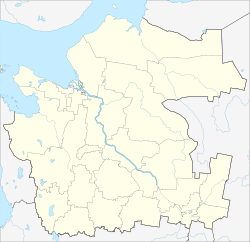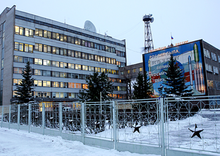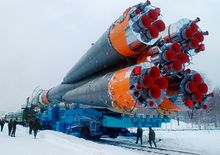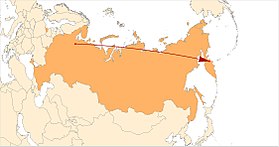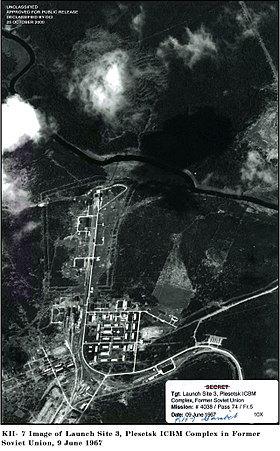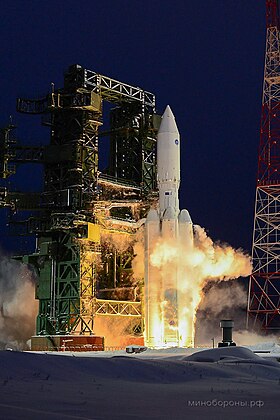
Soyuz is a family of expendable Russian and Soviet carrier rockets developed by OKB-1 and manufactured by Progress Rocket Space Centre in Samara, Russia. With over 2,000 flights since its debut in 1966, the Soyuz is the rocket with the most launches in the history of spaceflight.

The R-7 Semyorka, officially the GRAU index 8K71, was a Soviet missile developed during the Cold War, and the world's first intercontinental ballistic missile. The R-7 made 28 launches between 1957 and 1961. A derivative, the R-7A, was operational from 1960 to 1968. To the West it was unknown until its launch. In modified form, it launched Sputnik 1, the first artificial satellite, into orbit, and became the basis for the R-7 family which includes Sputnik, Luna, Molniya, Vostok, and Voskhod space launchers, as well as later Soyuz variants. Various modifications are still in use and it has become the world’s most reliable space launcher.
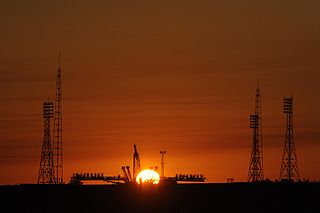
The Baikonur Cosmodrome is a spaceport operated by Russia within Kazakhstan. Located in the Kazakh city of Baikonur, it is the largest operational space launch facility in terms of area. All Russian crewed spaceflights are launched from Baikonur.
The Voskhod rocket was a derivative of the Soviet R-7 ICBM designed for the human spaceflight programme but later used for launching Zenit reconnaissance satellites. It consisted of the Molniya 8K78M third stage minus the Blok L. In 1966, all R-7 variants were equipped with the uprated core stage and strap-ons of the Soyuz 11A511. The Blok I stage in the Voskhod booster used the RD-0107 engine rather than the crew-rated and more powerful RD-0110 used on the Soyuz. The sole exceptions to this were the two crewed Voskhod launches, which had RD-0108 engines, a crew-rated RD-0107 but with the same performance.
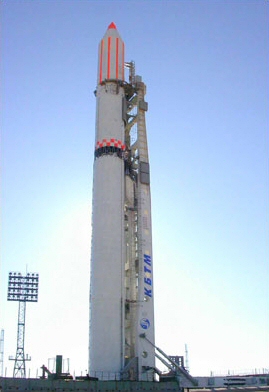
Zenit is a family of space launch vehicles designed by the Yuzhnoye Design Bureau in Dnipro, Ukraine, which was then part of the Soviet Union. Zenit was originally built in the 1980s for two purposes: as a liquid rocket booster for the Energia rocket and, equipped with a second stage, as a stand-alone middle-weight launcher with a payload greater than the 7 tonnes of the Soyuz but smaller than the 20 tonnes payload of the Proton. The last rocket family developed in the USSR, the Zenit was intended as an eventual replacement for the dated Soyuz and Proton families, and it would employ propellants which were safer and less toxic than the Proton's nitrogen tetroxide/UDMH mix. Zenit was planned to take over crewed spaceship launches from Soyuz, but these plans were abandoned after the dissolution of the Soviet Union in 1991.
The Tsyklon, GRAU index 11K67, was a Soviet-designed expendable launch system, primarily used to put Cosmos satellites into low Earth orbit. It is based on the R-36 intercontinental ballistic missile designed by Mikhail Yangel and made eight launches, with seven successes and one failure. All of its launches were conducted from LC-90 at the Baikonur Cosmodrome. It is sometimes designated Tsyklon-2A, not to be confused with the later Tsyklon-2 rocket. It was introduced in 1967 and was derived from the R-36 ICBM. It was retired in 1969.

The Angara rocket family is a family of launch vehicles being developed by the Moscow-based Khrunichev State Research and Production Space Center. The launch vehicles are to put between 3,800 kg (8,400 lb) and 24,500 kg (54,000 lb) into low Earth orbit and are intended, along with Soyuz-2 variants, to replace several existing launch vehicles.

The State Space Agency of Ukraine is the Ukrainian government agency responsible for space policy and programs. Along with the Ukrainian Defense Industry and the Antonov Aeronautical Scientific-Technical Complex, it is a major state complex of the national defense industry of Ukraine.The agency was formed in 1992 based on the Soviet space program infrastructure remaining in Ukraine following the dissolution of the Soviet Union.
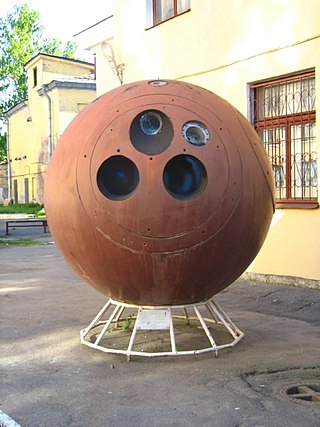
Zenit was a series of military photoreconnaissance satellites launched by the Soviet Union between 1961 and 1994. To conceal their nature, all flights were given the public Kosmos designation.

The Soyuz-U launch vehicle was an improved version of the original Soyuz rocket. Soyuz-U was part of the R-7 family of rockets based on the R-7 Semyorka missile. Members of this rocket family were designed by the TsSKB design bureau and constructed at the Progress factory in Samara, Russia. The first Soyuz-U flight took place on 18 May 1973, carrying as its payload Kosmos 559, a Zenit military surveillance satellite. The final flight of a Soyuz-U rocket took place on 22 February 2017, carrying Progress MS-05 to the International Space Station.

The Zenit-2 is a Ukrainian, previously Soviet, expendable carrier rocket. First flown in 1985, it has been launched 37 times, with 6 failures. It is a member of the Zenit family of rockets and was designed by the Yuzhmash.

The Vostochny Cosmodrome is a Russian spaceport above the 51st parallel north in the Amur Oblast, in the Russian Far East. It is intended to reduce Russia's dependency on the Baikonur Cosmodrome in Kazakhstan. The first launch took place on 28 April 2016 at 02:01 UTC. As of 1 July 2022, eleven launch attempts have been made with ten successes.

The R-7 family of rockets is a series of rockets, derived from the Soviet R-7 Semyorka, the world's first intercontinental ballistic missile (ICBM). More R-7 rockets have been launched than any other family of large rockets.
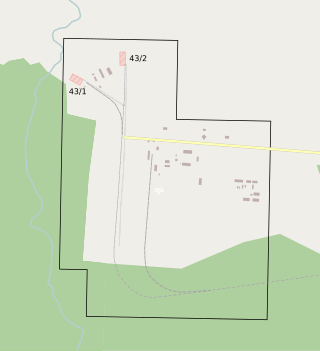
Site 43, also known as SK-3 and SK-4, is a launch complex at the Plesetsk Cosmodrome in Russia. It consists of a two pads, Sites 43/3 and 43/4, and has been used by R-7 derived rockets since the early 1960s.

The Soyuz-2.1v, GRAU index 14A15, known earlier in development as the Soyuz-1, is a Russian expendable launch vehicle. It is a heavily modified derivative of the Soyuz-2.1b, and is a member of the R-7 family of rockets. It is built by TsSKB Progress, at Samara in Russia. Launches are conducted from existing facilities at the Plesetsk Cosmodrome in Northwest Russia, with pads also available at the Baikonur Cosmodrome in Kazakhstan, and new facilities at the Vostochny Cosmodrome in Eastern Russia.
The Vostok-2, GRAU index 8A92 was an expendable carrier rocket used by the Soviet Union between 1962 and 1967. Forty five were launched, of which five failed. It was derived from the earlier Vostok-K, with uprated engines. It was a member of the Vostok family of rockets.

The Vostok-2M, GRAU index 8A92M was an expendable carrier rocket used by the Soviet Union between 1964 and 1991. Ninety-three were launched, of which one failed. Another was destroyed before launch. It was originally built as a specialised version of the earlier Vostok-2, for injecting lighter payloads into higher Sun-synchronous orbits. It was a member of the R-7 family of rockets, and the last Vostok.
The flight of Angara-1.2pp was the maiden flight of Russia's Angara series of rockets. This flight was conducted successfully on 9 July 2014. A unique configuration with parts taken from the Angara-1 and Angara-A5 rockets, the suborbital mission served to flight test each of the new stages developed for the rocket ahead of its operational use.

Irtysh, also named Soyuz-5, formerly codenamed Fenix in Russian and Sunkar in Kazakh, is a planned Russian rocket that is being developed by JSC SRC Progress within the "Project Feniks". Initially it will replace the capability of Zenit-2 and Proton Medium, and in the future will serve as the base of a super heavy-lift launch vehicle rocket (Yenisei) to match the Energia/Buran capabilities. As of August 2023, Irtysh is expected to launch from the Baikonur Baiterek, the ex Zenit-2 launch site, in a partnership with the government of Kazakhstan, with a planned debut in December 2025.



